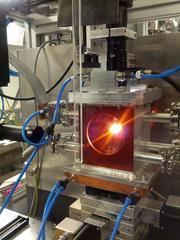URL: https://www.desy.de/news/news_search/index_eng.html
Breadcrumb Navigation
DESY News: High-temperature study opens view on movements in Earth's mantle
News
News from the DESY research centre
High-temperature study opens view on movements in Earth's mantle
Researchers have discovered a possible explanation for the behavior of certain seismic waves in Earth's mantle, which could help to accurately map processes in our planet's interior. With a newly developed experimental setup, X-ray investigations at DESY could elucidate the behaviour of the mineral ferropericlase at high pressure and high temperatures for the first time. The researchers led by Hauke Marquardt and Julia Immoor of the Bavarian Research Institute of Experimental Geochemistry and Geophysics (BGI) of the University of Bayreuth discovered a new orientation of the crystal structure of the mineral in conditions such as in the lower mantle, which could explain certain seismological observations. The international research team presents its findings in the journal Earth and Planetary Science Letters.

For the measurement, a new experimental set-up developed at DESY allowed to examine the mineral at high temperature and high pressure at the same time. Credit: Hauke Marquardt, BGI/Universität Bayreuth
In the lowest mantle, that is at a depth of about 2600 to 2900 kilometres, seismologists have long been able to observe an interesting phenomenon: so-called shear waves that pass through this depth are split into two different waves. “Imagine a stone thrown into water,” explains Marquardt. “The wave it causes moves horizontally away from the stone, at the same time the water moves vertically up and down. It is similar with the seismic shear waves. By splitting the shear waves at this depth, one wave becomes two, one horizontal and one vertical, both of which can be measured on the surface, with the horizontal wave moving faster.”
Observing the splitting of the waves could help to map Earth's interior more accurately. But the scientists need to know, how exactly the splitting comes about. One possible explanation is that because of their crystal structure, minerals in Earth's mantle align in a certain direction and form a so-called crystallographic preferential orientation. This preferred orientation results in a separation into two different waves with different propagation velocities. The scientists investigated if the mineral ferropericlase indeed aligns this way under conditions corresponding to the deep mantle so that it could cause the observed splitting of the waves. Ferropericlase ((Mg, Fe) O) is the second most abundant mineral in the lower mantle, it is relatively soft and easily deformed. In their experiments, the scientists analysed a sample with X-rays at temperatures of up to 1100 degrees Celsius and a pressure of up to 74 gigapascals, that is more than 100,000 times the pressure in a racing bicycle tire.

Simplified representation of a tectonic plate sinking to the core-mantle boundary and slowly rising again. Right (LLVSP) is an area where the shear waves travel very slowly. The measurement results can help to better understand and map such processes. Credit: Hauke Marquardt, BGI/Universität Bayreuth
A simulation based on the results of the measurement shows that this orientation of ferropericlase could explain the observed splitting of the waves. “Our investigation can help us to better understand the currents and motions in Earth's mantle,” says Marquardt. “If we know how the minerals behave in Earth's mantle and compare that to seismological observations, we may someday be able to determine how much and which materials are transported from the atmosphere and Earth's surface to the interior - and vice versa.”
Scientists from the Bavarian Research Institute of Experimental Geochemistry and Geophysicsof the University of Bayreuth, the GFZ German Research Centre for Geosciences in Potsdam, the University of Utah in the USA, the University of Lille in France and DESY participated in the study.
Reference :
Evidence for {100} slip in ferropericlase in Earth’s lower mantle from high-pressure/high-temperature experiments; J. Immoor, H. Marquardt, L. Miyagi, F. Lin, S. Speziale, S. Merkel, J. Buchen, A. Kurnosov, H.-P. Liermann; Earth and Planetary Science Letters, 2018; DOI: 10.1016/j.epsl.2018.02.045



